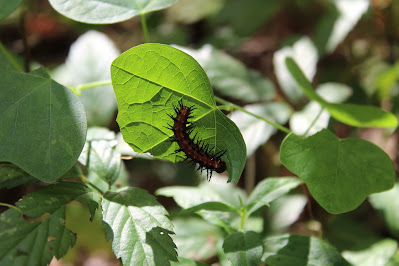Since we have been studying the caterpillar of the giant swallowtail (Papilio cresphontes), we might as well look at another interesting caterpillar, this time an arboretum favorite. The Gulf fritillary has appeared on the arboretum blog more than once (here and here). Summertime brings an abundance of yellow passionflower (Passiflora lutea) to the arboretum and every summer the fritillary comes back to enjoy it.
 |
| In this photo, we see an orange and black caterpillar attached to a yellow passionflower leaf. Over the course of the summer, the passionflower vine entwined itself with the dewberry vines growing on the west side of Mickle hall—the same patch of dewberry where the giant swallowtail caterpillar was found eating the young leaves of the toothache tree. |
Here we see the Gulf fritillary eating a leaf of the yellow passionflower. Currently, this is the only species of passionflower in the arboretum collection. We ought to make it a priority to plant purple passionflower (Passiflora incarnata) in the spring.
 |
| We briefly removed the caterpillar from its vine so that we could take a measurement. At the moment, it's less than an inch long. |
 |
| By contrast, the caterpillar of the giant swallowtail is inconspicuous: it both blends in with its environment and looks like something you want to avoid eating or even touching: a waste product. |
